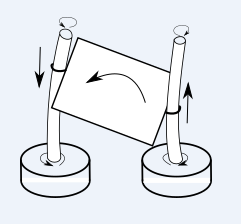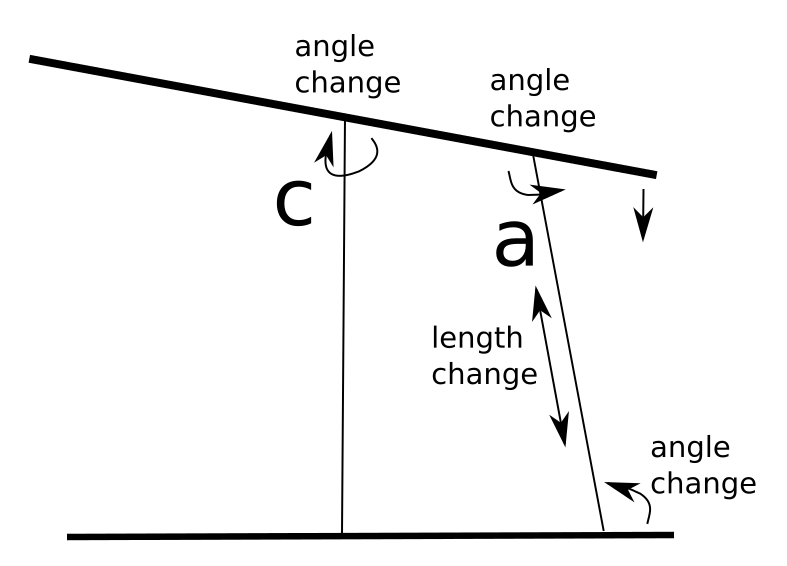The primary goal of the mirror is to reflect the light which shines somewhere where you don't want it to somewhere where you do want it.
There are plenty of solutions for this, and I just wanted to do it slightly differently. Not sure if it's better or worse. That all depends on the situation as well, doesn't it?
Objective #1 I want to make this setup as easy as possible to create/manufacture by someone at home (with simple tools), and objective #2 easy to source components. This may mean that some components could be cheaper if you did it differently, but then it would defeat objective #1 or #2.
Below you see my original plan. There are three screw threads, and by rotating them, one of the three corners moves up and down.

The idea is shown below; the two round things at the base represent motors, and by spinning them clockwise or counterclockwise, the screw at the end of the mirror moves up and down, rotating the mirror counterclockwise (for the viewer). This image only shows two screw threads to make it simpler to understand, but in reality there has to be a third leg otherwise you can only rotate in one plane.

But there are problems with this. When the mirror changes angle, the horizontal distance between the legs becomes larger or smaller. And there are several ways in which this can be solved. The first way is to change the angle of the screw threads, as shown in the photo at the top of this log. The second way is to allow the screw threads to bend, as shown as in the diagram directly above. I suppose there are more ways, but that's beside the point.
This all comes down to constraints. A constraint is essentially preventing movement in a plane. For instance, bicycle pedals can freely move in the vertical and forward-backward plane, but not in the horizontal and left-right plane. They are constrained to rotate in one plane only.
The problem with the first way is: if the angle of the screw threads is allowed to change in any direction, the mirror can rotate around its axis and/or otherwise become really unstable, as shown by this impala calf video:
I like that the second way is very elegant: the screw threads bend gently, similar to bamboo. But in reality, this would be quite difficult to get right; if the screw thread is too thin, the bend would be too strong, leading again to collapse or unpredictable mirror angles. If the screw thread is too thick, it would be too hard to bend, and the motors would have to do a lot of work.
In example 2, the constraints in all directions is supposed to come from the exact springiness of the screw threads, and that's hard to get right.
So solution 1 it is, BUT, the movement of the 'pillars' is constrained to specific directions.
SOLUTION 1
The picture below shows the concept. There is a central pillar 'c', and two pillars 'a' and 'b'.

The angle of pillar a is only allowed to change in the direction indicated by the arrows. The angle of pillar b is only allowed to change in a 90 degree angle (perpendicular) to the angle of pillar a, and pillar c is allowed to change in any angle.
The length of pillar a and b is allowed to change, but not the length of pillar c. To further illustrate this, please see the image below.

If you do the the same for pillar b, then you can tilt the mirror both in the a direction and the b direction.
If I've lost you by now, it will make more sense when I finally get a prototype and video. I hope that I have enough time until the deadline...
How to create these constraints? I'm thinking about using hinges for now.
Discussions
Become a Hackaday.io Member
Create an account to leave a comment. Already have an account? Log In.